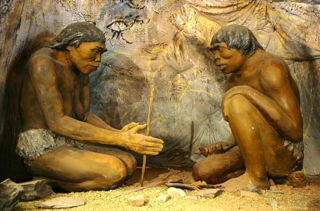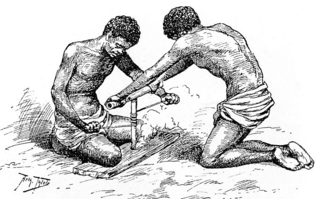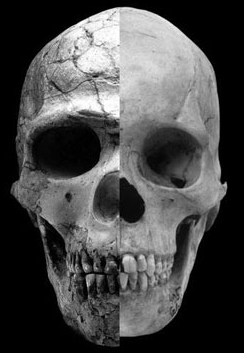Testosterone
Did a Drop in Testosterone Civilize Modern Humans?
New research connects testosterone and the emergence of civilized behavior.
Posted January 9, 2017 Reviewed by Abigail Fagan

The species we know as “anatomically modern humans” (Homo sapiens sapiens) dates back to around 150,000-200,000 years ago. While ancient humans resemble modern humans in their gross anatomy, they did not live anything like we do now, nor even like our hunter-gatherer forebears did. From 200,000 years ago, to around 65,000 years ago, Homo sapiens was just another hominin, barely distinguishing itself from the two or three other hominin species that were living at that time (Neanderthals, Denisovans, and isolated populations of H. floreseiensis and H. erectus surviving in some Pacific islands). Tools were crude; technology was scanty; culture was just beginning.
However, in Africa, around 65,000 years ago, humans' behavior suddenly began to change toward what we call behavioral modernity. Around this time, humans began fashioning much more advanced tools, constructing more sturdy dwellings, donning elaborate clothing and jewelry, and the signs of complex culture began to emerge.

Most anthropologists agree that the development of language provided this final piece that allowed humans to make this “great leap forward,” as it is often called. These new, fully modern humans, quickly spread around the globe, replacing and/or interbreeding with the more primitive humans wherever they went. Both the Denisovans and the Neanderthals went extinct within 10,000 years of the great leap forward. Another 20,000 or so years after that, humans were on the cusp of agriculture, livestock, and permanent settlements. Interestingly, those advancements were occurring more or less simultaneously in many parts of the world.
Despite the name “anatomically modern humans,” the members of our species that lived 200,000 years ago did not look exactly the same as humans do now. The differences are subtle, but measurable. If they suddenly appeared before us now, early humans would not look quite right. They would like, well, cavemen.
Scientists from Duke University recently took measurements of thousands of human skulls from various regions and archaeological ages. Some skulls came from human remains that were over 80,000 years old, some were close to 40,000 years old, some 10,000 years old, and many modern skulls were included as well. The authors painstakingly measured a variety of facial features, shapes, and sizes.
The authors found that, over the past 80,000 years, there have been a few gradual changes in the structure of the human face. The brow has become decreasingly prominent; the face has become more rounded; and the length of the upper cheeks (the distance between the mouth and the eyes) has decreased. These changes have happened in a slow and steady evolution of the human face.
See here the side-by-side comparison of the archaic human skull (left) with a modern one (right).

Although it is impossible to know for sure, these changes in the facial features of modern humans may have come about due to a gradual decrease in the circulating levels of testosterone in the species. The reasoning that supports this hypothesis is as follows:
It is known that men who have impaired production or reduced sensitivity to testosterone have an even less prominent brow, rounder face, and so forth. Conversely, men who grow and develop with chronically high testosterone develop the opposite, a prominent brow and long face. These testosterone effects are sometimes called the “masculinization” of the face.
Using that admittedly loaded lingo, the authors of this study found that the human face has become gradually less “masculine” over the past 80,000 years and they suspect that falling testosterone levels are the reason.
The most obvious implication of falling testosterone is that it could have played a major role in the transition between pre-modern humans and fully modern humans. This is based on another loaded assumption: that less testosterone has a “civilizing” affect on individuals and species. In order to cooperate in an organized hunt, establish division of labor within a community, and begin to settle down in large permanent settlements, humans had to be gentle and cooperative with each other, at least occasionally. A species whose members are constantly and fiercely competitive will have a difficult time living in pro-social harmony. In other words, civilized behavior means laying down the competition on occasion in order to work together.
This work, out of context, may seem to reinforce gender stereotypes such as, “women are mild and kind; men are ruthless and mean.” That is not the conclusion that this study necessarily leads to. First of all, it is important to remember that both men and women have measurable amounts of testosterone (and estrogen) in their bodies. Testosterone has real and important effects in both men and women. In hyenas, for example, females completely dominate males and oversee a fiercely competitive and hostile intra-sex social structure. The testosterone levels in hyenas are off the charts.
Secondly, the decreasing masculinization of the human face was observed in both sexes. If this is due to a reduction in testosterone, it would apply to both men and women. Thirdly, it is broadly believed that, on average, human females are more cooperative and egalitarian, while men are more competitive and self-serving. Of course, this notion is controversial and there are important debates regarding the competing roles of culture versus biology in that stereotype. However, its near-universality around the world speaks to a possible contribution of biology. (Also supported by biology is wide and overlapping ranges for these traits in both sexes. Neither misogyny nor misandry are bolstered by this.)
Most importantly, rather than focusing on individuals, this study considers the species as a whole. Indeed, levels of testosterone do inversely correlate with social-cooperative behaviors in other species of mammals. Broadly speaking, species of hyper-competitive, territorial anti-social mammals tend to have high circulating levels of testosterone. This includes species such as Tasmanian devils, coyotes, and orangutans, who all have higher testosterone than their more pro-social relatives. The opposite is also true, species with a more social and community-based lifestyle tend to have lower levels of testosterone.
The best contrast for this phenomenon is seen in the two closest relatives of humans: common chimpanzees and pygmy chimpanzees, also called bonobos. Common chimps are patriarchal and have a ruthlessly competitive social stratification. Bonobos, on the other hand, have a largely egalitarian and cooperative community structure. There is a dominance hierarchy, but it is dominated by females. Chimps usually resolve disputes with aggression and violence, sometimes fighting to the death. Bonobos tend to resolve disputes by relationship-restorative behaviors, often including sex. I probably don't have to mention that testosterone levels are considerably higher in chimpanzees than they are in bonobos, especially in males.
Even more convincing, within a species, the males with higher testosterone are more competitive and less social than males with lower testosterone. This is as true in humans as it is in other mammals. While the gender stereotypical implications make many of us uncomfortable, there are multiple lines of evidence that high testosterone promotes competition and low testosterone promotes cooperation.
This is why the study is so intriguing. Humans have more elaborate social interactions than any other species. Never was a pro-social tendency more essential as when nomadic hunter-gatherers began to settle down to form villages and towns. Division of labor only works under a system of cooperation and trust. Falling levels of testosterone may have been essential, or at least contributive, to the development of behavioral modernity.
None of this presumes to displace language as the key feature that allowed humans to take the great leap forward in our social and technological advancement. However, it may also be true that the leap might not have been possible if humans hadn’t also begun to trust and care for each other more closely. In a species just finding its voice, helpful, honest, and pro-social women and men might have found more success than brutish jerks prone to fighting and stealing.
While the hypothesis that lower testosterone contributed to the emergence of civilization is still tentative and even speculative, it has two major strengths: sound reasoning and, with this new study, experimental evidence.
To read the original article, click here.
References
Cieri, R. L., Churchill, S. E., Franciscus, R. G., Tan, J., & Hare, B. (2014). Craniofacial feminization, social tolerance, and the origins of behavioral modernity. Current Anthropology, 55(4), 419-443.




